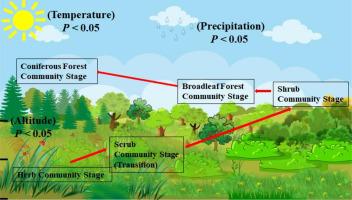Forest Ecology and Management ( IF 3.7 ) Pub Date : 2022-09-24 , DOI: 10.1016/j.foreco.2022.120542 Geng Qianwen , Muhammad Arif , Yuan Zhongxun , Zheng Jie , He Xinrui , Ding Dongdong , Yin Fan , Li Changxiao

|
Research into species composition and diversity in forest systems with successional stages can provide a scientific basis for optimal allocation and regulation of community structure. However, it is unclear how succession in arid and semi-arid forests changes the composition and diversity of species. The present study analyzed how species composition and diversity within successional gradients in arid and semi-arid areas of China evolved based on a spatially substituted temporal approach and identified the key factors influencing community composition and species diversity. Study findings have shown that species composition and life forms differ greatly between and among successional stages. In contrast, species richness is significantly lower in late-successional stages than in mid-successional stages. In the α-diversity, Shannon-Wiener diversity and Margalef richness reached an apex in the middle of the succession. At the same time, Pielou evenness and Simpson dominance did not change significantly over time. Except for Margalef richness, the α-diversity of different life forms throughout the successional gradient was consistent. The results of the β-diversity analysis indicate that the species turnover process has occurred during succession. It is evident that communities located at adjacent successional stages have high similarities in species composition. However, the loss or renewal of species was more advanced in the early and late stages, and the differences between communities were more evident. The main reasons for this can be attributed to differences in microhabitats (precipitation and temperature) and competition among species in various successional stages. It has been demonstrated that species diversity changes considerably in dry forest ecosystems as the ecosystem progresses through different stages of development. Effective conservation measures are needed to allow new species to establish themselves.







































 京公网安备 11010802027423号
京公网安备 11010802027423号